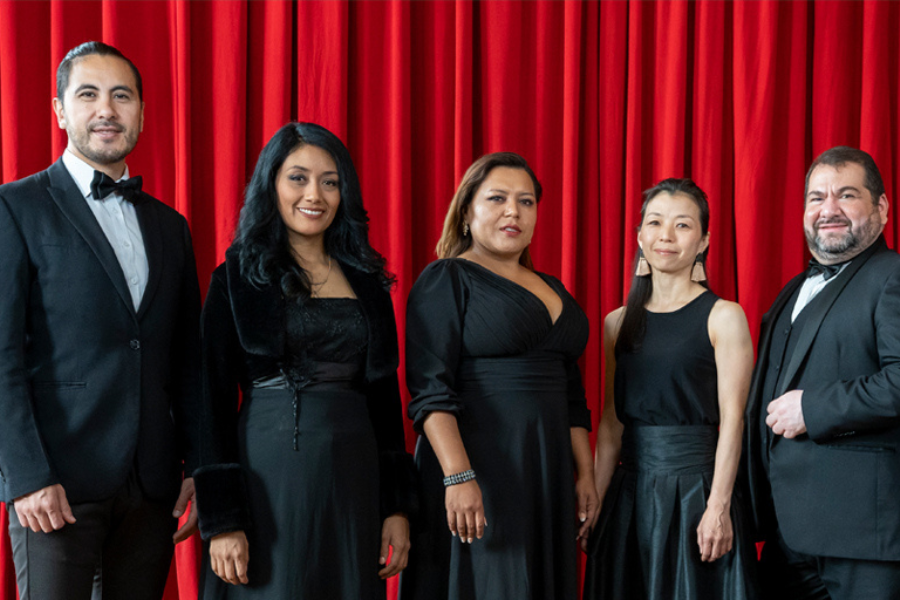De Bogotá a Lima, Carmina Burana llega al Gran Teatro Nacional
With more than 150 artists on stage and after two successful seasons, the first large format production of the Teatro Mayor Julio Mario Santo Domingo Carmina Burana by Carl Orff returns to perform at the Gran Teatro Nacional in Lima on the 18th, 19th and 20th of July.
Carmina Burana is the name of a manuscript discovered in the Benedictine Abbey of Beuern in Germany, in 1803, and which is one of the most important sources of profane music and literature of the twelfth and thirteenth centuries. In 1936, the German composer Carl Orff chose 24 poems from this manuscript, from which he took only the texts, mostly in Latin, some in Old German and Provencal for which he composed the music forming the cantata that we know today as Carmina Burana . The play premiered on June 8, 1937 in Frankfurt with a spectacular stage set designed by Ludwig Sievert.
The company L’Explose, the Argentinian soloist Santiago Burgui, a team of three technicians and costumes will travel to the Peruvian capital to launch this vast production that will be presented on July 18th, 19th and 20th at the Gran Teatro Nacional together to the National Symphony Orchestra, the National Choir and the Children’s National Choir of Peru.
Ramiro Osorio, General Director of the Teatro Mayor Julio Mario Santo Domingo in Bogota talks about Carmina Burana, the first major production of the Teatro Mayor, his success in Bogotá and Lima, and the value of networking.
“Carmina Burana is one of the most marvelous lyrical compositions and recognized by audiences around the world, Carl Orff with this work has conquered all audiences in all regions of the world. That is why we wanted to do it, knowing that it is of interest to the Colombian public, and what we wanted was to bet with a contemporary staging with the best national and foreign artists.
We are very pleased that our production is being presented at the Gran Teatro Nacional of Lima, which is one of the great stages in Latin America. Its premiere function was acclaimed by the public, which means that we really have a production of outstanding quality and that is the brand and the hallmark of what we have engaged in the Teatro Mayor.
In order to have a program of excellence today, both nationally and internationally, a very close and close relationship with the great theaters of our region is indispensable. We work permanently with the most outstanding and significant theaters in South America, such as the theaters of Buenos Aires, Santiago de Chile, Rio de Janeiro, São Paulo, Lima and Mexico. This makes it possible for us to propose to each other the presence of great orchestras, great artists, great ballets, which for reasons of cost would be impossible to bring to our countries. ”
Then Tino Fernández, Scenic Director of this production, told us about the construction and development of Carmina Burana:
Why did you decide to make a version of Carmina Burana, a work so represented in the world?
Actually, Teatro Mayor contacted us to do it and we presented a staging project to Ramiro Osorio (General Director of the Teatro Mayor Julio Mario Santo Domingo) who loved our proposal and right there they started doing things. Perhaps if it came from ourselves, we would have proposed another work or another composer. Today I think it has been a success and that our stage approach is something different from what has been done so far with this cantata.
What was the starting point for his staging?
The first thing we did with Juliana Reyes, the playwright of L’Explose, was to find the translation of these goliardos songs from the 12th and 13th century in order to have a better understanding of the work. Because it is a choral work, the need arose in the first instance to stage the whole choir, to build a choreographic score for those 70 voices. Those were the first two impulses that led us to the staging.
How did you build this proposal?
It was built in the first instance with ten dancers of the company in the studio behind closed doors. Then there was work with the whole chorus, about 70 choristers, plus the ten dancers, thirty-two voices from the children’s choir and three soloists for a total of one hundred and fifteen people on stage, plus the orchestra. It was something majestic, the passage from the micro to the macro was taking such a magnitude that we did not expect it ourselves.
Why is Carmina Burana one of the most famous lyrical works?
I believe that the work calls us to the joy of living, to earthly pleasures, carnal love, at the same time that criticizes the social and ecclesiastical estates and all this Carl Orff knew how to translate it very well to music. In any case, what I can say is that both the music and all these voices on stage make us vibrate in each of the rehearsals.
How would you define the aesthetics of your Carmina Burana?
I think it could be classified within a surrealist aesthetic, with very few scenic elements. With forty chairs, four metal tables and a video projected at the end of the stage, the audience is immersed in a timeless atmosphere where desire is present.
What is for you the most powerful of the work of Carl Orff?
I think that the most powerful thing of Carmina Burana is the wealth of contrasts that are within the same work; how to go from the public to the intimate, from the religious to the pagan, from the angelic to the earthly, from innocence to lust, getting surprised at every step of the work.






